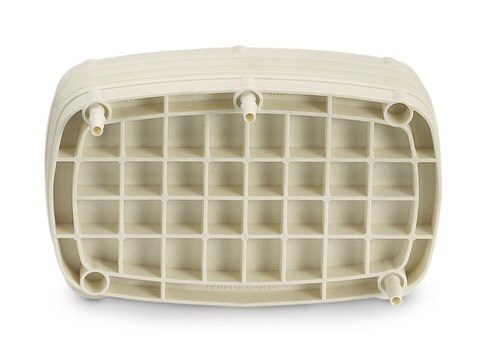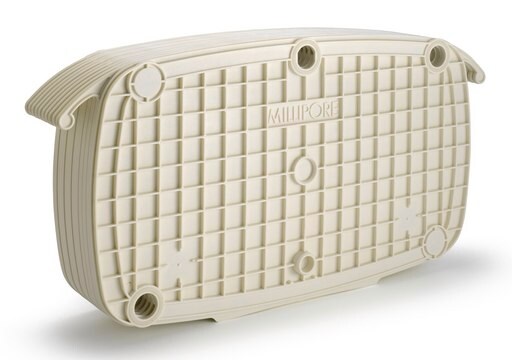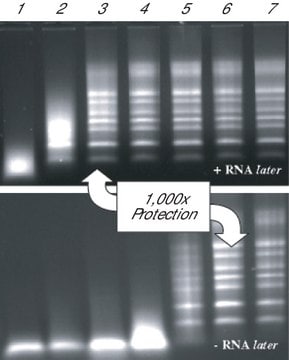11271164001
Roche
Interleukin-2, mouse (mIL-2)
recombinant (E. coli)
Sinónimos:
mIL-2, mouse interleukin-2
Iniciar sesiónpara Ver la Fijación de precios por contrato y de la organización
About This Item
UNSPSC Code:
12352207
Productos recomendados
biological source
mouse
Quality Level
recombinant
expressed in E. coli
assay
>95% (SDS-PAGE)
form
solution
potency
<0.5 ng/mL EC50
mol wt
17,200 Da
packaging
pkg of 10,000 U (5 μg, 1 ml)
manufacturer/tradename
Roche
storage condition
avoid repeated freeze/thaw cycles
technique(s)
inhibition assay: suitable
impurities
<0.1 EU/μgtested (LAL test)
UniProt accession no.
storage temp.
−20°C
Gene Information
mouse ... Il2(16183)
General description
Contents: 10,000 U/ml solution in PBS and 1 mg/ml BSA, filtered through a 0.2 μm pore size membrane
Interleukin-2 (IL-2, also known as T-cell growth factor, TCGF) is a lymphokine produced by lectin- or antigen-activated T-cells. It plays an important immunoregulatory role. This factor was first identified by its ability to promote the long-term in vitro proliferation of activated T-cells. It also promotes the generation and proliferation of cytotoxic T-cells, natural killer (NK) cells, and lymphokine-activated killer (LAK) cells. IL-2 also induces other lymphokines such as interferon-γ and B-cell growth factor (BCGF-1).
Recombinant Interleukin-2, mouse (mIL-2), is produced in E. coli and purified by standard chromatographic methods.
Specificity
Mouse IL-2 is effective on mouse cells, but not on human cells.
Application
Recombinant murine IL-2 is produced in E. coli and exhibits the following:
- Supports the growth of murine CTLL cells (murine T cell line), but not that of human T-cells.
- Strongly inhibits the binding of recombinant human IL-2 to murine responder cells.
- Weakly inhibits the binding to human responder cells.
- Shares identical biological and immunological activities with human IL-2.
- Is a convenient tool for extensive studies of the pharmacological and physiological activities of IL-2 in murine models.
- used for the stimulation of murine T-cells
Quality
Endotoxin level: <0.1 EU/μg (LAL-test), <10 EU/ml (LAL-test)
Sequence
Chain Length 149 AA
One polypeptide chain (149 amino acids), identical to natural mouse IL-2, but not glycosylated. Glycosylation is not essential for biological activity.
Unit Definition
EC50 definition: The amount of mIL-2 that is required to support half-maximal stimulation of cell proliferation (XTT cleavage) with CTLL-2 cells (1 unit equals ≤0.5 ng).
Preparation Note
Working solution: Dilute the concentrated IL-2 solution (10,000 U/ml) with PBS or culture medium containing 1 mg/ml BSA [or HSA (human serum alburnin)], or 1 to 10% serum (v/v).
Storage conditions (working solution): -15 to -25 °C
Note: Avoid repeated freezing and thawing.
Storage conditions (working solution): -15 to -25 °C
Note: Avoid repeated freezing and thawing.
Other Notes
Specific activity/EC 50: >2 x 106 U/mg, <0.5 ng/ml (hIL-2, NIBSC, 1st international standard, 86/504), at least the same specific activity (EC50) compared to the indicated standard is guaranteed.
Note: The biological activity of this product may vary in different in vitro applications. Determine the optimal concentration range for specific applications.
EC 50 definition/Unit definition: The amount of mIL-2 that is required to support half-maximal stimulation of cell proliferation (XTT cleavage) with CTLL-2 cells (1 unit equals =0.5 ng).
Note: The biological activity of this product may vary in different in vitro applications. Determine the optimal concentration range for specific applications.
EC 50 definition/Unit definition: The amount of mIL-2 that is required to support half-maximal stimulation of cell proliferation (XTT cleavage) with CTLL-2 cells (1 unit equals =0.5 ng).
For life science research only. Not for use in diagnostic procedures.
Storage Class
12 - Non Combustible Liquids
wgk_germany
nwg
flash_point_f
No data available
flash_point_c
No data available
Elija entre una de las versiones más recientes:
¿Ya tiene este producto?
Encuentre la documentación para los productos que ha comprado recientemente en la Biblioteca de documentos.
James Lee et al.
Methods in molecular biology (Clifton, N.J.), 506, 83-96 (2008-12-27)
In comparison to human T cells, efficient retroviral gene transfer and subsequent expansion of murine primary T cells is more difficult to achieve. Herein, we describe an optimized gene transfer protocol utilizing an ecotropic viral vector to transduce primary murine
Massimo Martinelli et al.
iScience, 26(1), 105860-105860 (2023-01-13)
The RNA-binding protein Pcbp2 is widely expressed in the innate and adaptive immune systems and is essential for mouse development. To determine whether Pcbp2 is required for CD4+ T cell development and function, we derived mice with conditional Pcbp2 deletion in
Anastasiia Kalinina et al.
STAR protocols, 2(1), 100368-100368 (2021-03-23)
Adoptive transfer therapy has great potential to treat diseases such as cancer as well as autoimmune and infectious diseases. Identification of chain-centric T cell receptors (TCRs) with the dominant-active antigen-specific α-chains (TCRα) can significantly improve the efficacy of adoptive cell therapy
Ping-Wei Zhao et al.
Mediators of inflammation, 2015, 762709-762709 (2015-04-22)
This study aimed to assess the differential expression of specific B cell subtypes in patients with chronic viral hepatitis. The frequencies of differential expression of specific B cell subtypes in patients with chronic viral hepatitis and healthy controls were assessed
Tae Joon Won et al.
Cellular signalling, 27(6), 1246-1252 (2015-03-13)
Small ubiquitin-like modifier (SUMO) 2 is a small protein that controls the activity and stability of other proteins by SUMOylation. In this study, T cell-specific SUMO2 overexpressing transgenic mice were generated to study the effect of SUMO2 on T lymphocytes.
Nuestro equipo de científicos tiene experiencia en todas las áreas de investigación: Ciencias de la vida, Ciencia de los materiales, Síntesis química, Cromatografía, Analítica y muchas otras.
Póngase en contacto con el Servicio técnico








